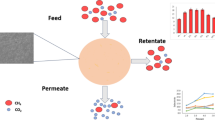Abstract
A “green” method to synthesize new composite membranes from a cellulose solution in phosphoric acid on various ultrafiltration substrates is proposed. The method can be used in industry; it differs from the conventional viscose method for producing cellophane and other known methods for synthesizing cellulose-based gas separation membranes by the absence of gaseous emissions and wastewater. The structure of the synthesized samples is studied by electron microscopy, X-ray diffraction, and thermal analysis (DSC). Analysis of the mechanical properties of the samples shows that the new membranes have better mechanical characteristics than those of homogeneous pure cellulose films synthesized in this study and commercial cellophane films. The gas transport properties of new membranes with respect to O2, N2, CO2, CH4, and He are studied. It is found that the proposed membrane synthesis method provides the formation of uniform dense gas separation layers of cellulose; the membranes show a three orders of magnitude higher gas permeability than that of cellophane films. It is shown that the highest ideal selectivity is exhibited by membranes with a gas separation layer of cellulose on viscose fabric substrates.





Similar content being viewed by others
REFERENCES
M. Ichwan and T. W. Son, J. Appl. Polym. Sci. 124, 1409 (2012). https://doi.org/10.1002/app.35104
M. S. M. Eldin, Encyclopedia of Membranes, Ed. by E. Drioli and L. Giorno (Springer, Berlin, 2014), p. 2279. https://doi.org/10.1007/978-3-64240872-4_1857-1
D. Klemm, Angew. Chem. Int. Ed. Engl. 44, 3358 (2005). https://doi.org/10.1002/anie.200460587
X. Jie, Y. Cao, and Q. Yuan, J. Appl. Polym. Sci. 91, 1873 (2004). https://doi.org/10.1002/app.2385
S. Sen, J. D. Martin, and D. S. Agruropoluos, ACS Sust. Chem. Eng. 8, 858 (2013). https://doi.org/10.1021/sc400085a
Q. Yang, H. Fukuzumi, Ts. Saito, et al., Biomacromolecules 12, 2766 (2011). https://doi.org/10.1021/bm200766v
Q. Xu, C. Chen, K. Rosswutm, and T. Yao, Carbohydr. Polym. 149, 274 (2016). https://doi.org/10.1016/j.carbpol.2016.04.114
L. Zhang, Q. Yang, and W. Fang, J. Membr. Sci. 56, 207 (1991). https://doi.org/10.1016/S03767388(00)80809-1
N. N. Li, A. G. Fane, and W. S. W. Ho, Advanced Membrane Technology and Applications (Wiley, Hoboken, 2008).
D. Nussbaumer, US Patent, No. 7,422,686 (2008).
R. Tucelli and P. V. McGrath, US Patent, No. 5,522,991 (1996).
D. D. Grinshpan, A. N. Gonchar, and N. G. Tsygankova, J. Eng. Phys. Thermophys. 84, 594 (2011). https://doi.org/10.1007/s10891-011-0510-z
D. D. Grinshpan, T. A. Savitskaya, F. N. Kaputskii, et al., Zh. Prikl. Khim., BGU, No. 6, 1342 (1988).
A. J. Sanjari and M. Asghari, ChemBioEng. Rev. 3, 134 (2016).https://doi.org/10.1002/cben.201500020
E. A. Efimova, D. A. Syrtsova, and V. V. Teplyakov, Sep. Purif. Technol. 179, 467 (2017).
X. Ju, et al., Carbohydr. Polym. 123, 476 (2015).
V. B. Filistovich, T. A. Savitskaya, I. M. Kimlenko, et al., Zh. BGU, Khim. 1, 66 (2019).
Topics in Applied Physics, vol. 35: Uranium Enrichment, Ed. by S. Villani (Springer, Berlin, 1979).
M. A. Herrera, A. P. Mathew, and K. Oksman, Carbohydr. Polym. 112, 494 (2014). https://doi.org/10.1016/j.carbpol.2014.06.036
J. Brandup, E. H. Immergut, and E. A. Grulke, Polymer Handbook, Ed. by A. Abe and D. R. Bloch, 4th Ed. (Wiley, New York, 1999), p. 2250.
M. Mulder, Basic Principles of Membrane Technology (Kluwer Academic, Dordrecht, 1996).
Membrane Materials for Gas and Vapor Separation: Synthesis and Application of Silicon-Containing Polymers, Ed. by Yu. Yampolskii and Eu. Finkelshtein (Wiley, Chichester, 2017).
Funding
The development and synthesis of the new membranes, the study of their structure, and the determination of the gas separation properties of the layers were conducted under the support of the Belarusian Republican Foundation for Basic Research (project no. Х18Р-176) and the Russian Foundation for Basic Research (project no. 18-53-00017). The technique for determining the parameters of gas transport across the new membranes was developed under the state task to the Topchiev Institute of Petrochemical Synthesis of the Russian Academy of Sciences.
Author information
Authors and Affiliations
Corresponding author
Additional information
Translated by M. Timoshinina
Rights and permissions
About this article
Cite this article
Syrtsova, D.A., Teplyakov, V.V., Filistovich, V.A. et al. Cellulose-Based Composite Gas Separation Membranes. Membr. Membr. Technol. 1, 353–360 (2019). https://doi.org/10.1134/S2517751619060052
Received:
Revised:
Accepted:
Published:
Issue Date:
DOI: https://doi.org/10.1134/S2517751619060052




